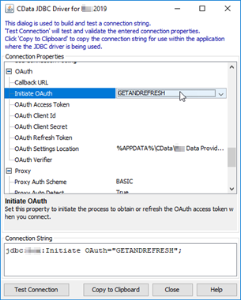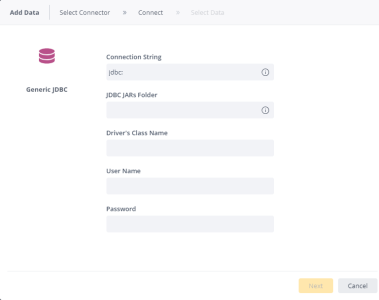Connecting to Xero Accounting
The Sisense Xero connector is a certified connector that allows you to import data from the Xero API into Sisense via the Sisense generic JDBC connector. The Xero connector offers the most natural way to connect to Xero data to search (Customers, Transactions, Invoices, Sales Receipts, etc.), update items, edit customers, and more, and provides additional powerful features.
The support for the connector is provided by Sisense and will be assisted by the certification partner's support, if needed. For any support issues or additional functionality requests, contact your Sisense representative or open a request through the Sisense Help Center . For advanced inquiries specific to driver functionality, you can also contact the certification partner’s support directly via support@cdata.com .
After you have downloaded and installed the connector, you can connect through a connection string you provide Sisense in Sisense. The connection string is used to authenticate users who connect to the Xero APIs. Once you have connected to Xero, you can import a variety of tables from the Xero API.
This page describes how to download the Xero driver and deploy it, how to connect to Xero with a connection string, provides information about the Xero data model, and more.
Downloading the Xero JDBC Driver
You can download the Xero JDBC driver here .
For a short video of downloading the driver, see below (the video uses the Box driver as an example).
Note:
- The driver is certified for Sisense v7.2 and above.
- Sisense v7.4 and above: Click the above link to download a ready-to-use driver.
- Sisense prior to v7.4: Click the above link to download a 30-days free-trial of the driver. Contact Sisense for the full license version.
Deploying the Driver
Prerequisite: The install file (setup.jar) is a Java Application that requires Java 6 (J2SE) or above to run.
To install the driver, double-click the setup.jar file and proceed with the instructions in the installation wizard.
Depending on the machine on which you are accessing the Sisense application, install the driver in one of the following locations:
-
When Sisense is installed on your local machine , deploy the driver locally.
-
For a non-local installation (when accessing Sisense on a remote Windows server, or accessing the Sisense hosted cloud environment), select one of the below methods:
- Deploy the driver on the Sisense server machine, and then perform all the authentication on the server machine.
OR - Deploy the driver on your local machine (or any other machine, as convenient), perform all the authentication on that machine, and then copy the JAR file to the remote server.
- Deploy the driver on the Sisense server machine, and then perform all the authentication on the server machine.
Note :
The default location of the JAR file: C:\Program Files\CData\CData JDBC Driver for <Driver Name> 2019\lib
For a short video of the process, see below (the video uses the Box driver as an example).
JAVA Troubleshooting
If you do not have Java 6 installed, you may download it from here .
If your system is not set up to run Java applications, execute the following command: java -jar setup.jar .
Connecting to Xero
To access Xero’s REST API from Sisense, you must provide valid Oauth Xero credentials through a connection string. After you receive your credentials from Xero, you can create the connection string and provide Sisense with it to connect to your data.
To create the connection string:
-
Open the lib directory for the connector. This is the default path:
C:\Program Files\CData\CData JDBC Driver for <Driver Name> 2019\lib. -
Double-click the jar file in the lib directory.

Alternatively, to open the jar file from the command line, enter the following command in the command prompt (change the driver name to your driver):
cd C:\Program Files\CData\CData JDBC Driver for <Driver Name> 2019\lib. Press Enter and then enter the following command (change the driver name to your driver):“C:\Program Files\Sisense\infra\jre\bin\java.exe" -jar cdata.jdbc.<Driver Name>.jar.Press Enter again.
For example:

The Connection String Builder opens.
-
Click in the Value column of the Initiate OAuth property and select GETANDREFRESH .

-
Click Test Connection .
-
A browser window opens where you need to log in to your application in order to grant access. (Each application will display a different window and messages.)
Close the Authorization Successful! message that opens.
-
Go back to the Connection String Builder dialog and click OK in the Test Connection Successful message to close it.
-
Click Copy to Clipboard to obtain the connection string.
For a short video of the process, see below (the video uses the Box driver as an example).
The driver uses embedded credentials which originate from a OAuth App embedded into the driver. The embedded credentials provide full functionality, so you do not have to create an OAuth App.
Note :
If you want to configure the authentication or limit the scope of the data provided to Sisense, you will need to create your own OAuth App. For details, see here .
You need to follow the above instructions only once, to retrieve the Access and Refresh tokens. Once the tokens have been retrieved, the driver will be refreshing them in the background when they expire, with no further involvement from you.
Adding Xero Tables to your ElastiCube
-
Open Sisense.
For a non-local installation, open Sisense on the hosted cloud environment.
-
In the Data page, open an ElastiCube or create a new ElastiCube .
-
In the Model Editor, click
 . The Add Data dialog box is displayed.
. The Add Data dialog box is displayed.
-
Click Generic JDBC to open the JDBC settings.

-
In Connection String , paste the string you obtained above. When you do so, the string is appended with some
_persistproperties. The following is an example of the connection string as it looks in Sisense:jdbc:box:InitiateOAuth="GETANDREFRESH";_persist_oauthexpiresin=3199;_persist_token_timestamp=1561893244662;_persist_oauthaccesstoken=mswNfVDVpnBZc3pkQQja7WRHNebbaGZL;_persist_oauthrefreshtoken=ybofHX3Vrd7C8cPhE5ZysVxFiUmkJSiw2htjPL0nKDBgpqjcyGP6Am7KNaDzqhZz; -
In JDBC JARs Folder , enter the name of the directory where the Xero JAR file is located.
-
In Driver's Class Name , enter the following class name:
cdata.jdbc.xero.XeroDriver. -
Leave the User Name and Password blank.
-
Click Next . A list of tables in the database are displayed. All tables and views associated with the database will appear in a new window.
-
From the Tables list, select the relevant table or view you want to work with. You can click next to the relevant table or click Preview to see a preview of the data inside it.
-
(Optional) Click + to customize the data you want to import with SQL. See Importing Data with Custom Queries for more information.
-
After you have selected all the relevant tables, click Done . The tables are added to your data model.
For a short video of the process, see below (the video uses the Box driver as an example).
Additional Resources
For the full documentation set for the Xero connector, click here .
For connection string options, click here .
For information on the Xero data model, click here .
Limitations
XERO API
To access the AgedPayablesByContact and AgedRecievablesByContact tables, you need to specify a particular ContactID, the unique ID of the Contacts table, in the SELECT query using a WHERE clause. This allows you to retrieve data for a specific contact. These are limitations of the Xero API, as these reports are specific to each contact. Here’s an example:
SELECT due, paid, total FROM AgedPayablesByContact WHERE ContactID='xyz'
SELECT duedate, reference FROM AgedRecievablesByContact WHERE ContactID='1234'
Due to this limitation, you cannot build an ElastiCube with these tables without custom SQL.
Daily Limit
There is a daily limit of 5000 API calls against a single Xero organisation in a rolling 24-hour period.
In addition to the daily limit, a single access token can only be used up to 60 times in a rolling 60-second period.
Encountering a Rate Limit
If you encounter a rate limit, the Xero API will return an HTTP 503 (Service Unavailable) error, with the following message: “oauth_problem=rate limit exceeded”.
Note:
If you encounter a rate limit, do not continue to make requests, as this may continue to add to your limitation. If necessary, you may need to queue requests.
Token Limitations
- If you connected to Xero data by following the steps in Connecting to Xero (above), then you are using a Public App for connection. In a Publish App, each access token will only last for 30 minutes. If you want longer access to the organization, you need to re-authorize your application every 30 minutes.
- To re-authorize , repeat the steps in Connecting to Xero (above) in the Connection String Builder dialog. Repeat this process each time the token expires. For further details, click here .
- To avoid having to re-authenticateevery 30 minutes, you need to connect to Xero by registering a Private App. There you will need to provide the OAuth-related credentials (OAuthAccessToken, OAuthClientId and OAuthClientSecret) along with a digital certificate.
Click here for instructions on creating a Private/Public Key Pair with the Certificate Generator tool. Run the tool, tell it where to export the public and private keys, and generate them. To learn more on creating the digital certification, see in the ‘Authentication with a Private Application’ section here .
Create a new application in the Xero Developer Portal and upload the public key. It will give you a Consumer Key and Consumer Secret.
Open the Connection String Builder dialog. Set the Certificate options so that they use the new certificate. Set the OAuthAccessToken property. Set the Consumer Key and Consumer Secret you received above in the OauthClinetId and OauthClientSecret properties.
Click Test Connection in the dialog. This will generate a connection string that will not expire after 30 minutes.
.r.